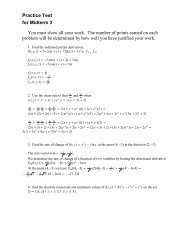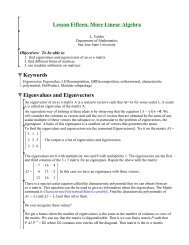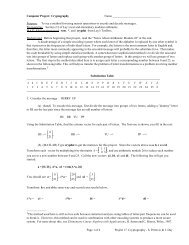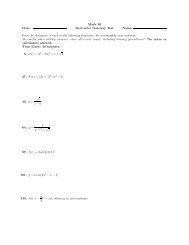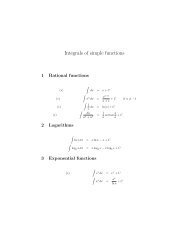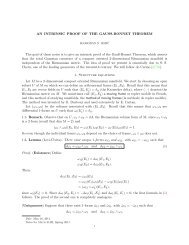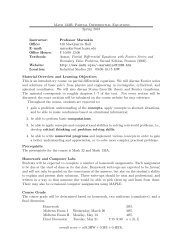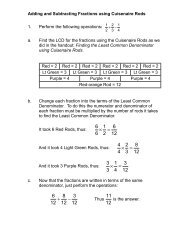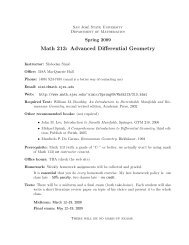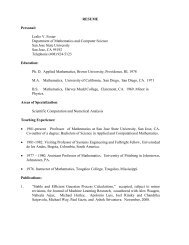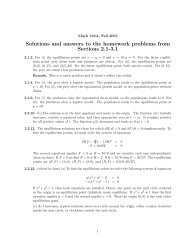Solutions to the Practice Test for Midterm 3 You must show all your ...
Solutions to the Practice Test for Midterm 3 You must show all your ...
Solutions to the Practice Test for Midterm 3 You must show all your ...
Create successful ePaper yourself
Turn your PDF publications into a flip-book with our unique Google optimized e-Paper software.
<strong>Solutions</strong> <strong>to</strong> <strong>the</strong> <strong>Practice</strong> <strong>Test</strong> <strong>for</strong> <strong>Midterm</strong> 3<strong>You</strong> <strong>must</strong> <strong>show</strong> <strong>all</strong> <strong>your</strong> work. The number of points earned on eachproblem will be determined by how well you have justified <strong>your</strong> work.1. Find <strong>the</strong> second partial derivatives of fÝx,yÞ = e x y 2 ? x 2 y + xlny.f x Ýx,y,zÞ = e x y 2 ? 2xy + lnyf y Ýx,y,zÞ = 2e x y ? x 2 + x yf xx Ýx,y,zÞ = e x y 2 ? 2yf yy Ýx,y,zÞ = 2e x ? xy 2f xy Ýx,y,zÞ = 2e x y ? 2x + 1 y2. Find an equation of <strong>the</strong> tangent plane <strong>to</strong> <strong>the</strong> surface r3Ýu,vÞ = 3u i + uv 2 j ? v 3 k at <strong>the</strong> pointÝ?6,?2,?1Þ.We first look <strong>for</strong> <strong>the</strong> direction numbers of <strong>the</strong> normal vec<strong>to</strong>r by finding <strong>the</strong> tangent vec<strong>to</strong>rs:r3 u = 3 i + v 2 jr3 v = 2uv j ? 3v 2 kThe normal is <strong>the</strong> cross product of <strong>the</strong>se two vec<strong>to</strong>rs:i j k3 v 2 0 = ?3v 4 i + 9v 2 j + 6uvk0 2uv ?3v 2The point Ý?6,?2,?1Þ occurs when u = ?2,v = 1. So <strong>the</strong> normal vec<strong>to</strong>r at <strong>the</strong> point is-3 i + 9 j ? 12kThere<strong>for</strong>e, <strong>the</strong> tangent plane has <strong>the</strong> equation ?3Ýx + 6Þ + 9Ýy + 2Þ ? 12Ýz + 1Þ =? 3x ? 12 + 9y ? 12z = 03. Let xsinÝy + zÞ + ycosÝx + zÞ + ze x = 0. Find /z /z, and ./x /yWe know that /z/x= ? /F//x/F//z, and/z/y= ? /F//y/F//z ./F//x = sinÝy + zÞ ? ysinÝx + zÞ + ze x/F//y = xsinÝy + zÞ + cosÝx + yÞ/F//z = xcosÝy + zÞ ? ysinÝx + zÞ + e x/z= ? sinÝy+zÞ?ysinÝx+zÞ+zex/x xcosÝy+zÞ?ysinÝx+zÞ+e x/z= ? xsinÝy+zÞ+cosÝx+yÞ/y xcosÝy+zÞ?ysinÝx+zÞ+e x4. Find <strong>the</strong> maximum rate of change of fÝx,yÞ = x 3 siny ? tany at <strong>the</strong> point Ý1,2Þ. In whichdirection does it occur?The maximum value of <strong>the</strong> directional derivative is |4fÝx,yÞ| =|Ö3x 2 siny,x 3 cosy ? sec 2 y×|.At <strong>the</strong> pointÝ1,2Þ,|4fÝ1,2Þ| = |Ö3sin2,cos2 ? sec 2 1×| = 9sin 2 2 + cos 2 2 ? 2cos2sec 2 1 + sec 4 2 = 6.6189
The maximum rate of change occurs in <strong>the</strong> direction of4fÝx,yÞ = Ö3sin2,cos2 ? sec 2 2× r Ö2.7279,?6.1905×5. Find <strong>the</strong> absolute maximum and minimum values of fÝx,yÞ = x 2 y + x 2 y 2 ? xy in <strong>the</strong> closedtriangular region D with vertices Ý?3,0Þ,Ý3,0Þ, and Ý0,3Þ.We first find <strong>the</strong> critical points by setting <strong>the</strong> first partials equal <strong>to</strong> 0.f x Ýx,yÞ = 2xy + 2xy 2 ? y = yÝ2x + 2xy ? 1Þ = 0 ì y = 0 or 2x + 2xy ? 1 = 0f y Ýx,yÞ = x 2 + 2x 2 y ? x = xÝx + 2xy ? 1Þ ì x = 0 or x + 2xy ? 1 = 0We see immedieately that Ý0,0Þ is a critical point.If y = 0 and x + 2xy ? 1 = 0 <strong>the</strong>n x + 2xÝ0Þ ? 1 = x ? 1 = 0 ì x = 1, and Ý1, 0Þ is a criticalpoint.If 2x + 2xy ? 1 = 0 <strong>the</strong>n x ® 0.If 2x + 2xy ? 1 = 0 and x + 2xy ? 1 = 0, <strong>the</strong>n x = 2x ì x = 0 which is not possible.There<strong>for</strong>e, <strong>the</strong>re are two critical points:Ý0,0Þ ,Ý1,0Þ.fÝ0,0Þ = 0,fÝ1,0Þ = 0We now find <strong>the</strong> value of <strong>the</strong> function along <strong>the</strong> edges of D.L 1 := áÝx,yÞ| ? 3 ² x ² 0,y = 0â ì fÝx,0Þ = 0.L 2 := áÝx,yÞ|y = ?x + 3,0 ² x ² 3â ì fÝx,?x + 3Þ = Ý?x + 3ÞÝx 2 + x 2 Ý?x + 3Þ ? xÞ =? 7x 3 + x 4 + 13x 2 ? 3xWe check <strong>for</strong> <strong>the</strong> extreme values of this function by taking <strong>the</strong> derivative:f v Ýx,?x + 3Þ = 4x 3 ? 21x 2 + 26x ? 3 = 0, Solution is : áx = .12837â,áx = 1.7151â,áx = 3.4065â ì Ý.12837,2.8716Þ,Ý1.7151,1.2849Þ,Ý3.4065,?.4065Þ will yield any extremevalues:fÝ.12837,2.8716Þ = .12837 2 2.8716 + .12837 2 2.8716 2 ? .12837Ý2.8716Þ = ? .18542fÝ1.7151,1.2849Þ = 1.7151 2 1.2849 + 1.7151 2 Ý1.2849Þ 2 ? 1.7151Ý1.2849Þ = 6.4323Ý3.4065,?.4065Þ is not in <strong>the</strong> triangular region.L 3 := áÝx,yÞ|y = x + 3,?3 ² x ² 0â ì fÝx,x + 3Þ = Ýx + 3ÞÝx 2 + x 2 Ýx + 3Þ ? xÞ =7x 3 + x 4 + 11x 2 ? 3xWe check <strong>for</strong> <strong>the</strong> extreme values of this function by taking <strong>the</strong> derivative:f v Ýx,x + 3Þ = 4x 3 + 21x 2 + 22x ? 3 = 0, Solution is : áx = ?3.7153â,áx = ?1.6566â,áx = .12186â, Solution is : áx = ?3.7153â,áx = ?1.6566â,áx = .12186â ì Ý?3.7153, ? .7153Þ,Ý?1.6566,1.3434Þ,Ý.12186,3.12186Þ will yield any extreme values:?3.7153, ? .7153 is not in <strong>the</strong> triangular regionfÝ?1.6566,1.3434Þ = ?1.6566 2 1.3434 + 1.6566 2 Ý1.3434Þ 2 ? ?1.6566Ý1.3434Þ = 3.491 5Ý.12186,3.12186Þ is not in <strong>the</strong> triangular regionThe absolute minimum is fÝ.12837,2.8716Þ = ? .18542, and<strong>the</strong> absolute maximum is fÝ1.7151,1.2849Þ = 6.4323.6. Use Lagrange multipliers <strong>to</strong> find <strong>the</strong> maximum and minimum values of f subject <strong>to</strong> <strong>the</strong> givenconstraint.fÝx,y,zÞ = x 2 + y 2 + z 2 ; x ? y + z = 12x = V2y = ?V2z = VBy <strong>the</strong> first and third equations we have x = zBy <strong>the</strong> first and second equations we have y = ?xUsing <strong>the</strong> constraint x ? y + z = 1 we have x + x + x = 1 ì x = 1/3, z = 1/3,y = ?1/3
fÝ1/3,1/3,1/3Þ = 1/3 2 + 1/3 2 + 1/3 2 = 1 . 3Choosing any Ýx,y,zÞ such that x ? y + z = 1, such as Ý1,0,0Þ ì fÝ1,0,0Þ = 1, we can deducefÝ1/3,1/3,1/3Þ = 1 is a minimum value.3



